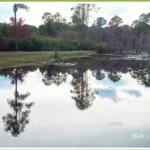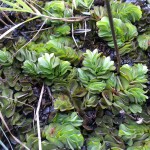
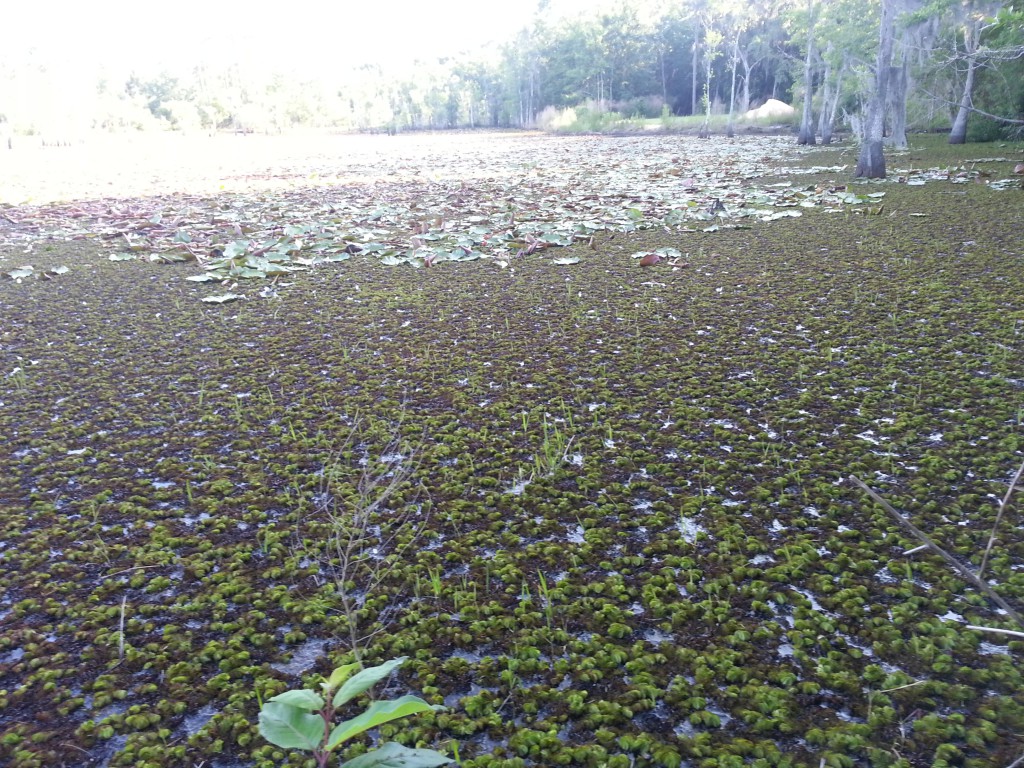
Giant Salvinia mats completely covering Bay County pond. This fast growing invasive can double in size every week! Photo by L. Scott Jackson
Matthew Phillips and Scott Jackson –
UF/IFAS Extension and Research works with many partners supporting invasive species management actions and strategies across Florida. One key partner is the Florida Fish & Wildlife Conservation Commission (FWC), Invasive Plant Management Section. FWC Biologists provide resources and expertise to address threats from Florida’s most disruptive invasive species. FWC and UF/IFAS have worked together for years. They have teamed-up to help residents make the best cost-effective management decisions to preserve unique habitats and ecosystems. Most days are filled with routine questions from land managers and pond owners but on rare occasions there are days we will never forget.
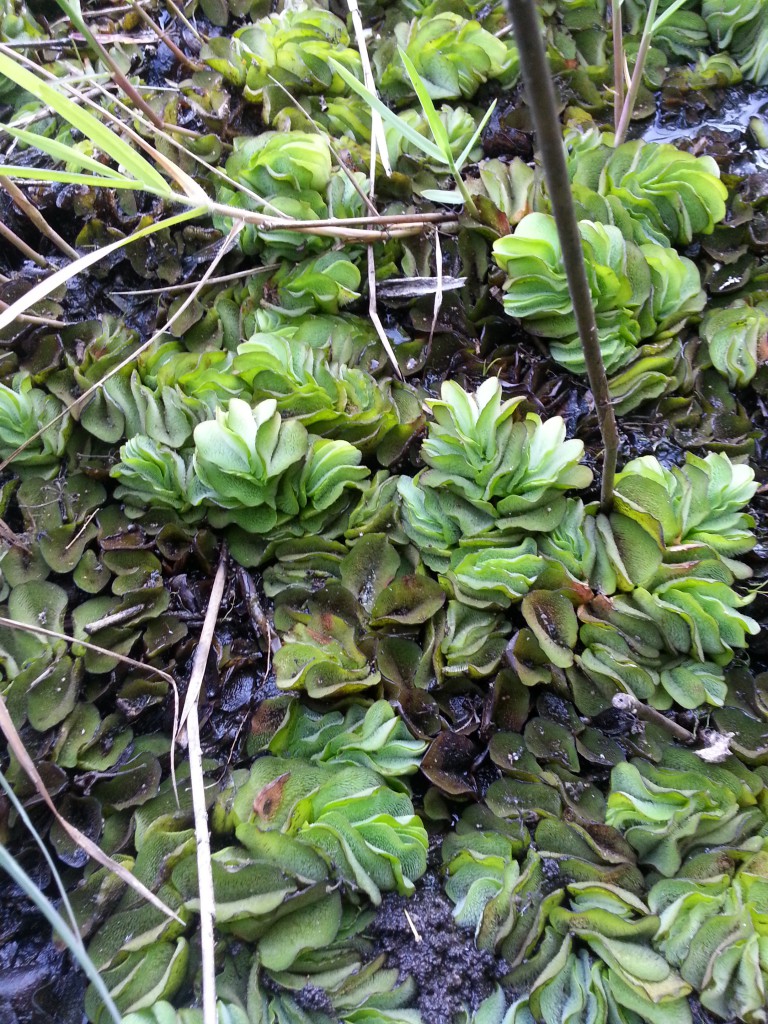
Active growing Giant Salvinia was observed growing out of the pond water on to moist soils and emerging cypress and tupelo tree trunks. Photo by L. Scott Jackson
Giant salvinia (Salvinia molesta) is an invasive free-floating aquatic fern from South America that is rarely observed in Northwest Florida. The species is on the Federal Noxious Weed List and the Florida Prohibited Aquatic Plants List. After a site visit with a pond owner, Scott Jackson, a University of Florida/IFAS Extension Agent, identified Salvinia molesta in the Bay County pond and notified the Florida Fish and Wildlife Conservation Commission’s (FWC) Invasive Plant Management Section. Their staff confirmed the identification of the specimen and a second voucher specimen was transferred to the Godfrey Herbarium at Florida State University.
Jackson reported the observation on the Early Detection and Distribution Mapping System (EDDMapS) housed at the University of Georgia’s Center for Invasive Species and Ecosystem Health. This was only the second reported occurrence of giant salvinia in Northwest Florida. It is a high control priority for the state of Florida due to its high invasive potential.
Giant salvinia has caused severe economic and environmental problems in Texas and Louisiana and in many countries including New Zealand, Australia, and South Africa. Giant salvinia grows rapidly and produces a dense floating canopy on the surface of ponds, lakes, and rivers. It aggressively spreads by vegetative fragments and thrives in slow-moving, nutrient-rich warm fresh water. Floating mats of giant salvinia shade out native submersed vegetation and degrade water quality.
Mats also impede boating, fishing, swimming, and clog water intakes for irrigation and electrical generation.1 Salvinia molesta has been listed in The World’s Worst Weeds – Distribution and Biology2 since 1977. It was recently added to 100 of the World’s Worst Invasive Alien Species, an all taxa list compiled by invasion biologists with the Global Invasive Species Database.3
The most distinguishing physical characteristic of Salvinia molesta is the basket- or egg beater-like hairs on the upper leaves (a hand lens is required) which distinguishes it from common salvinia (Salvinia minima). Common salvinia also has hairs on the upper leaf surface but they do not form basket-like structures at the tips. The upper leaves of both species repel water.
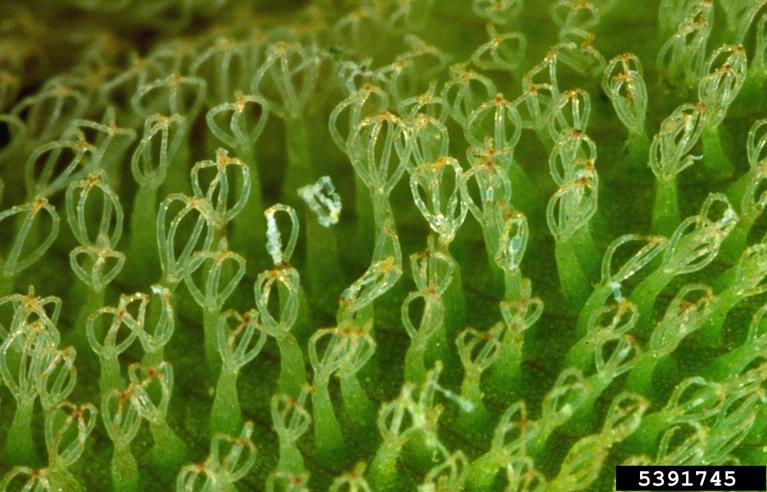
Photo by Barry Rice, sarracenia
.com, Bugwood.org Rows of egg beater or light bulb shaped leaf hairs are a unique identifying characteristic of giant salvinia.
The location of the giant salvinia infestation found by Jackson is precariously close to Deer Point Lake, a 5,000 acre water body that is the main source of drinking water for Panama City and surrounding Bay County. The 2.5 acre infestation was on a 3.6 acre divided pond and both sections were treated. Treatment of the infestation was initiated by FWC in June 2013 at no expense to the property owners.
The pond continues to be monitored and, to date, there have not been any signs of living Salvinia molesta. We will continue to monitor the pond to make sure there is no re-establishment of giant salvinia. Investigations continue to try and learn more about the introduction of the pernicious species to this isolated pond.
Read more about the successful treatment regime FWC Biologists used to control giant salvinia in Northwest Florida. This was published in Florida Aquatic Plant Management Society’s publication “Aquatics” – see page 5.
WJHG 7 in Panama City ran this news story. Please see their webpage for additional information and video. “Invasive Plant Threatens Deer Point Lake“.
1 Giant salvinia (Salvinia molesta), Weed Alert, Florida Fish & Wildlife Conservation Commission, Tallahassee, FL, 2 pp.
2 The World’s Worst Weeds – Distribution and Biology. 1977 and 1991. L.G. Holm, D.L. Plucknett, J.V. Pancho, and J.P. Herberger. 609 pp.
3 Alien species: Monster fern makes IUCN invader list. 2013. Nature 498:37. G.M. Luque, C. Bellard, et al.
Matt Phillips is an Administrative Biologist with the Florida Fish & Wildlife Conservation Commission, Invasive Plant Management Section in Tallahassee; (850) 617-9430; Mattv.phillips@myfwc.com Scott Jackson is a University of Florida/ IFAS Sea Grant Extension Agent, Bay County; (850) 784-6105; LSJ@ufl.edu
Posted: February 26, 2016
Category: Invasive Species, Natural Resources
Tags: 2016, Florida, Giant, Molesta, NISAW, Northwest, Panhandle Outdoors, Remove, Salvinia, Together, Working, “From
![NISAW-logo09[1]](http://nwdistrict.ifas.ufl.edu/nat/files/2014/02/NISAW-logo091.jpg)
